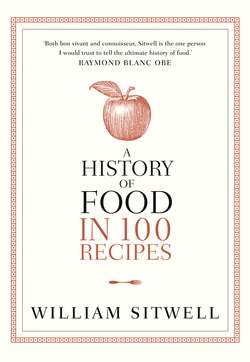Читать книгу A History of Food in 100 Recipes - William Sitwell - Страница 29
Оглавление22
Hippocras jelly
1530
AUTHOR: Unknown,
FROM: Register of Evidences and Documents Concerning the Family of Stafford, Barons and Earls of Stafford, and Dukes of Buckingham
Wine 3 gallons
Cinnamon 8oz
Ginger 2oz
Nutmegs and Cloves 1oz
Sugar 3lb
Graines [grains of paradise spice] 2oz
This recipe made hippocras – you just needed to add isinglass, hartshorn, calves’ feet or ivory shavings to turn it into jelly!
Our experience of jelly today is pretty limited. We serve it at children’s parties – normally set in a big dish, having simply dissolved lab-created fruit-flavoured tablets in water to create it. We dish it out at student parties using the above method but adding vodka. We then, as adults, serve the student version again in an attempt to bring back those heady days of youth. However, vodka jelly is actually an historic throwback to rather more glamorous times than your own recollections of attempting to manoeuvre around drunk people and cheap furniture in whatever tip of a flat you might have been partying in.
The earliest recorded alcoholic jelly was served at a dinner thrown by Henry VIII. Blink while perusing the menu of a get-together at Windsor in May 1520 and you might miss it. There are only two words and they come in a long list of dishes served over two evenings of entertainment at the castle. ‘An ordinance for the King, the Queen, and the Knights of the Garter at Windsor for Saturday Supper and Sunday Dinner the 28 and 29 days of May,’ is how the event was advertised.
The two meals each had two courses, not that you should think that that made it a simple occasion. Each course comprised between fourteen and nineteen dishes. They flowed out of the kitchen: soups, fish (including salmon, pike, tench and sturgeon), chickens, quail, rabbits and more – the usual story. But the end of three of the four courses that were served over the two days was marked by the arrival of jelly – described in its ancient form of ‘leche’ or ‘leach’, which is jelly served in a more sophisticated fashion. Leach could come in the form of castle, or an animal. It could be multi-coloured. Doubtless its arrival merited the odd ‘ooh’, ‘ahh’, a possible whoop and probably some clapping.
There is no early recorded recipe for hippocras jelly, but the one heading this chapter, taken from the pages of a manuscript housed in the British Library, is from the same period and just needs a spot of gelatine to turn it into jelly. There were a variety of sources to choose from. Sometimes it was extracted from the bladder of sturgeon (isinglass), at other times from the antlers of male red deer (hartshorn). Calves’ feet were another good source, providing a high level of collagen and, more importantly, a neutral flavour. Raspberry jelly made using a calf’s foot might not sound appealing, but actually it’s rather more appealing than gelatine, the setting agent for modern jelly.
But it is not so much the jellies served at the end of the courses during that Windsor get-together that merit our attention, as the jelly served as the second plate of the second course during the Sunday dinner – in between ‘A sotelte’ and a ‘Kind Kid’. It was ‘Jely Ypocrass’ – that is, jelly hippocras.
Hippocras is an ancient type of mulled wine and while the fifth century physician Hippocrates might well have drunk it – indeed might have advocated its befits to health – the word comes from the name of the bag used to filter the wine. The manicum Hippocraticum – the sleeve of Hipocrates – was conical in shape and was used to strain the liquid, getting rid of any unwanted particles, while letting the spicy juice run clearer. Certainly mulled wine brings on feelings of warm well-being, although a hippocras is not necessarily heated. A jellied version would have made a spirited addition to the lavish proceedings. Henry’s Knights of the Garter enjoyed his favour for the likes of capturing Boulogne, raiding Calais or because they were the father of his current wife. They needed to make the most of their privileged times at the king’s court as life was precarious. One moment you’d be guffawing and wolfing down some boozy jelly, the next you might fall from favour and end up in the Tower or worse. And that’s a poor place to be when you’ve got the Tudor equivalent of a vodka jelly hangover.
